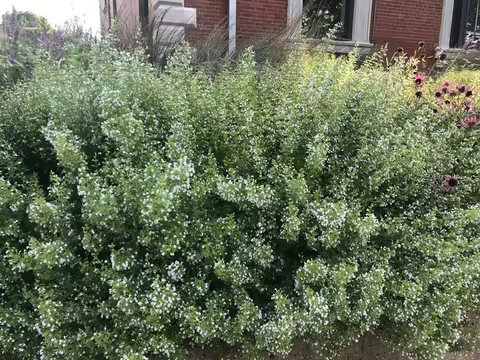URBANA, Ill. – As constant as the New Year’s Eve ball drop in New York City, every year the Perennial Plant Association presents its plant of the year. Its 2021 choice is calamint, a sun-loving, low-growing, bushy perennial with long-lasting blooms that benefit pollinators.
“Like a cloud of confetti, tiny white flowers, sometimes touched with pale blue, appear on calamint branches from early summer to fall,” says Martha Smith, University of Illinois Extension horticulture educator.
Since 1990, Perennial Plant Association members have voted for a standout perennial to showcase annually. These plants are always low maintenance with multiple-season interest and are suitable for a wide range of growing climates, according to the association.
Calamint, Calamintha nepeta subsp. Nepeta, is a member of the mint family and is an excellent companion for an herb garden, does wonderfully in containers, and is lovely cascading over low retaining walls.
“It is low maintenance, undemanding, and dependable and is the perfect companion for other summer bloomers and foliage,” Smith says.
With blooms from early summer until frost, calamint supports bees, butterflies, and other pollinators, while its aromatic foliage is deer resistant.
Native from southern Europe to Great Britain, calamint prefers full sun and will tolerate partial afternoon shade. It does best in soils with good drainage, but once established, it can be drought tolerant. Plants grow up to 2 feet tall and 2 feet wide and work well as an edge planting.
It is a favorite in stylized meadows, matrix plantings, and other modern perennial designs. Gardeners can also create a lovely monochromatic garden with past plants of the year, such as Anemone xhybrida ‘Honorine Jobert’ and Phlox paniculata ‘David,’ or complemented with ornamental grasses, such as switchgrass, Panicum virgatum ‘Northwind,’, or little bluestem, Schyzacharium scoparium.
Gardeners may have noticed that the scientific name of calamint refers to a sub-species, (subsp.), instead of a plant variety, (var.). The difference is a matter of taxonomic semantics. The two terms are interchangeable, according to the International Association for Plant Taxonomy. Much like the metric vs. imperial systems of measurement, European plant taxonomists use subspecies, while North American taxonomists prefer variety.
Calamint is easily started from seed. It may spread in the garden by rhizomes, or self-seeding to form an interesting ground cover. Stems touching the ground may root at the nodes.
Shear or cut back plants after flowering to tidy the planting, to remove unsightly foliage, or to prevent any unwanted self-seeding.
To see calamint in its full glory, visit Lurie Garden in Chicago, where it is planted in several areas.
SOURCE: Martha Smith, Horticulture Educator, Illinois Extension
WRITER: Emily Steele, Media Communications Coordinator
ABOUT EXTENSION: Illinois Extension leads public outreach for University of Illinois by translating research into action plans that allow Illinois families, businesses, and community leaders to solve problems, make informed decisions, and adapt to changes and opportunities.
PHOTO ACCESS: The photo in this article is available to download for media use.
